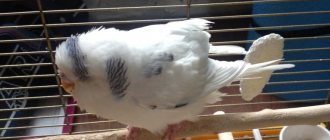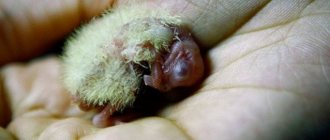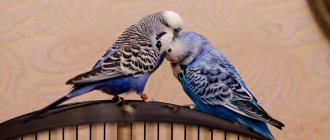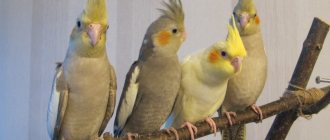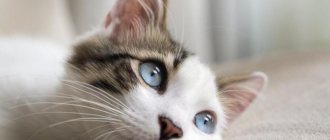A good owner knows a lot about his winged friend, but one can only guess why a parrot suddenly dies at home. When a person gets a tame parrot at home, he is preparing for a long life for his ward. There are several reasons for sudden death, which will be discussed in the article. You will learn what the signs of a dangerous condition are, whether your pet can be saved and what to do if it dies.
Why do parrots die
The fate of poultry depends on what care and maintenance the owner provides it. The lion's share of deaths occurs due to negligence of the owners. A person cannot always accurately determine that a parrot is dying. Trying to find the cause of the pet’s depressing condition, the owner wastes time. Meanwhile, the death of a parrot is provoked by two groups of factors: internal and external.
Internal factors
This category includes congenital and acquired diseases. The list of deadly diseases is impressive:
- tumors;
- infections (ornithosis, salmonellosis, tuberculosis);
- severe pathologies of feathers;
- endocrine system disorders;
- parasites;
- bird plague;
- developmental defects.
What can cause a parrot to die prematurely? The causes are often poor heredity or gender characteristics. Domesticated birds can live for a long time next to people and die only in old age.
Genetics
Chicks received from sick parents are born doomed. They have a set of genes with defects that do not allow them to live long. It is not always obvious from the appearance of a young parrot that he has a developmental defect. Therefore, the owner may not expect the imminent death of the ward. The bird is kept in good conditions, leads an active lifestyle, eats properly - and suddenly dies in the prime of life.
This is interesting! Parrots of spectacular show breeds are in most cases born from inbreeding. Despite their beautiful appearance, they are very weak in health and die early.
Bad purchase
If a novice poultry farmer goes to the market to buy a pet or takes it from the previous owner through an advertisement, he runs the risk of buying an elderly individual. Such a parrot will not live long in a new family: it will die of old age or stress. Middle-aged birds have difficulty getting used to another place of residence, become very sad and soon die. In addition, sick parrots are sold in dubious places, passing them off as healthy. Birds with weakened immune systems cannot withstand harsh conditions and die.
Reproductive system
The mortality rate is higher in females than in males. This is due to the characteristics of the reproductive system: females lay eggs and hatch chicks. If breeding episodes are repeated more than twice a year, the bird's body becomes depleted. In young individuals, especially during the first clutch, the birth process is difficult. Sometimes the egg lingers in the cloaca, putting pressure on the internal organs. Vital functions are disrupted and the parrot may die.
External factors
This group includes circumstances caused by the environment. In life, a parrot faces various difficulties. Many tame birds die from physical stress, emotional stress, and the conditions of their keeping.
Stress
Parrots are sensitive and capable of experiencing anxiety, fear, and sadness. Breeders are well aware of situations when, after a strong fright, a healthy bird dies. Simply moving to a new apartment, even with the same owner, becomes a cause of stress for the bird. Lonely individuals are at particular risk: without enough attention, they get bored and cannot occupy themselves. Over time, melancholy gives way to deep depression, the parrot refuses to eat, and he develops the habit of plucking feathers. If you do not bring the ward out of this borderline state, he will die.
Accident
Lovers of domestic animals are confident that nothing threatens tame parrots. This carelessness often turns against them: their feathered charges die due to oversight.
Common causes of death from injuries:
- burns from boiling water or open fire;
- electric shock;
- drowning;
- collision with an obstacle;
- pinching;
- animal attack;
- strangulation.
Attention! Children often accidentally cause severe injuries to birds. When letting a pet fly freely around the apartment, an adult family member must monitor and protect it.
Poisoning
Poisoning should be considered a separate item among dangerous incidents. Parrots are very curious; they try everything around with their beak. Sometimes such a craving for everything new leads to dire consequences: the feathered pet dies.
What substances cause poisoning?
- finishing materials (glue, paint, polyurethane foam, solvents);
- juice of poisonous indoor plants;
- household chemicals;
- Teflon.
With prolonged regular exposure to toxic fumes, the bird receives damage to internal organs that is incompatible with life. The most dangerous substances include household gas, aerosols, and tobacco.
Living conditions
A tame parrot must be closely monitored so that it does not die. Poor maintenance reduces a bird's chances of longevity. The owner may believe that his lifestyle is suitable for the ward, but the pet is forced to suffer. Fragile ornamental birds easily lose their health when exposed to unsanitary conditions, drafts and direct sunlight. Food of dubious quality disrupts digestion, and the parrot becomes infected with parasites through dirty water. If the bird is already sick, lack of proper care will only accelerate its death.
Why do budgies die?
They can become prey for a cat or dog the moment you let the bird out for a walk. They can easily fly out even through a slightly open window, and only to meet their certain death in freedom.
These birds are very curious and active; it often happens that they get used to human hands and can beg for human food. And if a person treats them to sausage, fish, or sweet dishes, then as a result of accelerated metabolism, the parrots quickly develop poisoning.
Also, the wavy can easily get entangled in ladders, ropes, curtains, and in a fit of fear it twitches even more, damaging its limbs and wings. When letting your pet go for a walk around the house, be careful; if he gets under the pillow, he will no longer be able to get out on his own, and this leads to suffocation.
How to understand that a parrot is dying
When a parrot is on the verge of life and death, it cannot be ignored. Based on changes in the behavior and appearance of the parrot, not only doctors, but also owners may suspect imminent death.
What are the signs that indicate a bird is about to die?
- regurgitation;
- convulsions;
- chaotic movements;
- head thrown to one side;
- paws are tense;
- film on the eyes;
- the parrot lies on its stomach or back;
- paralysis.
The bird is in agony from one hour to a day. In another scenario, events do not develop so clearly. The parrot dies quickly and quietly, without much suffering. Is it possible to save a pet? If you provide help on the spot, there will be little time left to get to the veterinarian.
How to help a dying parrot
With the rapid progression of the disease, death is inevitable; the best medicines and excellent care will not help. In other cases, there is a chance that the parrot will not die, but here a significant role is played by the internal forces of the body. The owner must quickly decide what to do if his parrot dies. Having assumed what caused the dangerous condition, you need to urgently apply all available methods of assistance.
Support measures depending on the source of danger:
- Injury - apply a bandage to the wound, fix the fracture, hold the bird in your hands;
- Cramp - warm the pet by wrapping it in a towel;
- Shortness of breath and shock - inject with a corticosteroid intramuscularly;
- Poisoning – drink sorbent several times;
- Diarrhea and vomiting – take glucose and saline solution;
- For a chemical burn, lubricate the eyes with solcoseryl and also inject it into the beak.
Attention! At home, you can only temporarily support the life of a parrot with the necessary medications. After which you must definitely contact a specialist.
What can a budgie die from?
Fans of feathered animals most often get budgerigars - small, fragile birds, in which death occurs literally from a click. Kids let out for a walk even get into the slightly open window. Flying out into the street is what can kill a tame budgerigar.
We recommend reading: TOP 10 most beautiful parrots in the world
Tiny birds have a fast metabolism, and all processes in the body occur instantly. The birds beg people for food, and they do not refuse them, treating them to sweets, chips and sausage. It would seem a trifle, but such products cause poisoning, which is why budgies living at home die.
Once entangled in ropes, ladders, and chains, the bird cannot get out on its own. In panic, he twitches chaotically, damaging his wings and legs. The result is death from fright or injury. Another reason why a budgie died at home is suffocation. While walking around the apartment, the singing baby climbed under the pillow, where it died.
What to do if the parrot died
If you were unable to save your parrot, your worries are understandable. But you shouldn’t be discouraged, but you need to take care of a speedy burial. When the cause of death has not been established or the bird died after an infectious disease, the infection should be removed and the cage treated.
Burial
Dead birds cannot be buried within the boundaries of a populated area. If your city has a pet cemetery, this is a good option. An alternative is a summer cottage or forest belt. Having chosen a place on a hill, they dig a half-meter hole in the ground. The preferred depth is such that predatory animals cannot reach the body. The parrot is wrapped in cloth, placed in a box, which is then placed on the bottom. The hole is filled and compacted.
Cell disinfection
After the death of a pet, it is extremely rare that an autopsy is performed on the body, so it is impossible to reliably know the cause. But birds spread dangerous diseases: psittacosis, salmonellosis, chlamydia. The cage in which the parrot lived and died must be carefully treated, even if no one else will be placed in it.
Disinfection is carried out with creolin or xylonaft. Before using aggressive agents, wear a respirator, gloves, and goggles. Cover the cage with a disinfectant and leave for half an hour, and then rinse with plenty of water. Finally, scald with boiling water and dry for a week. After this, it can be used for other birds. Household items are soaked in the Ecocid-S solution. Dilute the liquid at the rate of 1 tablespoon per liter of water. If there are no further plans for feeders and toys, they are thrown away after disinfection.
Internal factors
Heredity
If everything was fine with the parrot, it was kept in normal conditions, ate properly, led an active life, but suddenly died, then do not rush to blame yourself. It is possible that genetic predisposition played a role. Perhaps the bird's parents hereditarily passed on a latent disease to it, which crippled the pet.
Place of purchase
If you bought a parrot at a bird market, in a dubious pet store, or simply do not know how to determine the age of a bird, then they could easily slip you an old parrot. The fact is that such pets look the same as young individuals after a year. In this case, the bird simply died of old age.
At the same market or in a pet store (of course, if it is not a huge specialized chain of stores) you could be sold a sick bird. Often, budgies are kept in poor conditions, where there is no microclimate necessary for the normal functioning of pets, and there is low-quality, monotonous food.
This state of affairs contributes to the weakening of bird immunity and it is sometimes impossible to change this. Therefore, a seemingly normal bird begins to wither after a while and eventually dies.
Influence of gender
The sex of the pet can also affect avian mortality. The body of a female who lays eggs too often may simply not withstand such physical and mental stress, despite proper nutrition. And in some cases, the female may die if one of the eggs gets stuck while laying eggs. The danger is that the stuck egg compresses the vital organs of the bird, which leads to its death.
Another equally important condition is that lonely domesticated males, eager to meet a female, can begin to feed the mirror. They do not understand that this is their reflection and try in every way to make friends with it. But, since the reflection cannot answer them, the birds fall into deep depression and gradually die from both loneliness and hunger. Therefore, experts do not recommend hanging mirrors in the cage of lonely pets.
It is also necessary to take into account that budgerigars are precisely those birds that choose a mate forever. Therefore, if one of the couple dies, there is a chance that the other will die of melancholy. Even if the pet is absolutely healthy.
How to cope with loss
Each person copes with the death of a beloved pet in their own way. Some people isolate themselves alone with sadness, others need to talk it out and cry. If a parrot lived in a family for a long time and became attached to it, it will take more than one month for the pain to subside. This method often helps: get another animal that will return you to a full life, although it will not replace your pet.
When a parrot that has become part of the family dies, it is a grief for the owner and his loved ones. It no longer makes much difference whether the bird died from old age, illness or injury. But while he is alive, you need to treat him carefully, care for and protect him. And if trouble happens, you need to do everything possible to save yourself.
Causes of sudden death of a parrot
Now we can only guess what could have caused the death.
- Heart attack, stroke. Such reasons for the rapid death of a bird may be a consequence of congenital pathology. The listed diseases sometimes arise as a result of an undetected infection of a sluggish nature.
- A large number of illnesses occur without visible symptoms. The bird could be sick for a long time, and its ill health hardly showed itself.
- There are also a lot of little-studied ailments of birds - various inflammations of internal organs and all kinds of tumors, etc.
- Stress is one of the most common reasons why you can suddenly lose a feathered pet. Any noise, bright light, a cat jumping, or an attempt to trim a pet’s overgrown claws – all this is a risk of sudden death. Moreover, there may be a time interval between the stressful event and death, or the pet will die as soon as it gets scared.
- If the parrot had contact with other birds, it could become infected with something from them. Moreover, the birds themselves may not be sick, but they can be carriers of infections.
- Even just being near other birds, for example at an exhibition, is a risk for a parrot. Some dangerous infections are transmitted through the air.
- The presence of worms poisons the parrot's body from the inside, and as a result it dies.
- Injuries, even minor ones, can be fatal.
- Contact with other animals is a potential danger. Even a light blow from a cat's paw in flight or a small bite subsequently leads to the death of the parrot - due to infection or stress. Contact with rodents is also a potential risk.
- High temperatures are, oddly enough, destructive for tropical residents. Heat and overheating of the body cause shortness of breath, dehydration and, finally, death.
- Parrots die as a result of hereditary causes, drafts, infections entering the house, mold fungi, and allergic substances.



